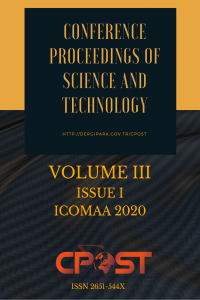Konferans Bildirisi
Yıl 2020,
Cilt: 3 Sayı: 1, 68 - 76, 15.12.2020
Öz
Acceptance sampling plans (ASPs) offers to inspect a small set instead of all outputs in a production process. This approach minimizes the inspection cost dramatically and guarantees the output quality within a predefined risk ratio based on a small sample size. One type of ASPs named double acceptance sampling plans (DASPs) gives an ability to minimize the effect of the randomness on inspection results and reach a lower risk level with a small sample size. We know that the ASPs use certain values while formulation and application procedures. However, it is also clear that quality characteristics may not be certain in some real cases and they include some vagueness. So, we need some new techniques to model the uncertainty and manage human’s evaluations. The fuzzy set theory (FST) is one of the most popular techniques to model the uncertainty in the engineering problems. Additionally, we know that the fuzzy extensions such as Neutrosophic sets (NSs) bring some advantages to manage these uncertainties. Generally, fuzzy DASPs is offered in the literature but it is formulated with α-cut approach to convert the problem into interval valued set problem. With the help of this conversion, it is enough to solve the problem with certain values for the upper and the lower limits of the intervals. However, the uncertainty is generally more complex in real life applications including human factor. NSs that include three terms, truthness (t), indeterminacy (i) and falsity (f) and cover inconsistent data cases are good representation of human thinking under uncertainty. In this study, DASPs are formulated and analyzed based on NSs by using binomial distribution. A numerical example is also presented to analyze the proposed sampling plans based on NSs.
Anahtar Kelimeler
Acceptance double sampling plans Binomial distribution Fuzzy sets Neutrosophic sets
Kaynakça
- 1 Y. H. Chun, D. B. Rinks, Three types of producer’s and consumer’s risks in the single sampling plan, Journal of Quality Technology 30(3), 1998, pp. 254-268.
- 2 D. C. Montgomery, Introduction to statistical quality control, Wiley, 2009.
- 3 L. A. Zadeh, Fuzzy sets, Information and Control, 1965, pp. 338-353.
- 4 C. Kahraman, B. Oztaysi, S. C. Onar, Fuzzy sets applications in complex energy systems: a literature review, Energy Management—Collective and Computational Intelligence with Theory and Applications, 2018, pp. 15-37.
- 5 K. T. Atanassov,Intuitionistic fuzzy sets past, present and future, EUSFLAT Conf., 2003, pp. 12-19.
- 6 F. Smarandache, Neutrosophic set-a generalization of the intuitionistic fuzzy set, International Journal of Pure and Applied Mathematics, 2005, p. 287.
- 7 H. Wang, F. Smarandache, Y.Q. Zhang, R. Sunderraman, Interval neutrosophic sets and logic: theory and applications in computing (Vol. 5), Infinite Study, 2005.
- 8 F. Smarandache, Introduction to neutrosophic statistics, Infinite Study, 2014.
- 9 E. B. Jamkhaneh, B. S. Gildeh, G. Yari, Acceptance single sampling plan with fuzzy parameter, Iranian Journal of Fuzzy Systems, 2011, pp. 47-55.
- 10 C. Kahraman, E. T. Bekar, O. Senvar, A fuzzy design of single and double acceptance sampling plans, Intelligent Decision Making in Quality Management, 2016, pp. 179-211.
- 11 L. A. Zadeh, The concept of a linguistic variable and its application to approximate reasoning—I, Information Sciences, 1975, pp. 199-249.
- 12 M. Aslam, A new attribute sampling plan using neutrosophic statistical interval method, Complex & Intelligent Systems, 2019, pp. 1-6.
- 13 G. Isik, I. Kaya Analyzing single acceptance sampling plans based on neutrosophic poisson distribution, International Marmara Science and Social Sciences Congress. (IMASCON), 2020, pp. 597-604.
Yıl 2020,
Cilt: 3 Sayı: 1, 68 - 76, 15.12.2020
Öz
Kaynakça
- 1 Y. H. Chun, D. B. Rinks, Three types of producer’s and consumer’s risks in the single sampling plan, Journal of Quality Technology 30(3), 1998, pp. 254-268.
- 2 D. C. Montgomery, Introduction to statistical quality control, Wiley, 2009.
- 3 L. A. Zadeh, Fuzzy sets, Information and Control, 1965, pp. 338-353.
- 4 C. Kahraman, B. Oztaysi, S. C. Onar, Fuzzy sets applications in complex energy systems: a literature review, Energy Management—Collective and Computational Intelligence with Theory and Applications, 2018, pp. 15-37.
- 5 K. T. Atanassov,Intuitionistic fuzzy sets past, present and future, EUSFLAT Conf., 2003, pp. 12-19.
- 6 F. Smarandache, Neutrosophic set-a generalization of the intuitionistic fuzzy set, International Journal of Pure and Applied Mathematics, 2005, p. 287.
- 7 H. Wang, F. Smarandache, Y.Q. Zhang, R. Sunderraman, Interval neutrosophic sets and logic: theory and applications in computing (Vol. 5), Infinite Study, 2005.
- 8 F. Smarandache, Introduction to neutrosophic statistics, Infinite Study, 2014.
- 9 E. B. Jamkhaneh, B. S. Gildeh, G. Yari, Acceptance single sampling plan with fuzzy parameter, Iranian Journal of Fuzzy Systems, 2011, pp. 47-55.
- 10 C. Kahraman, E. T. Bekar, O. Senvar, A fuzzy design of single and double acceptance sampling plans, Intelligent Decision Making in Quality Management, 2016, pp. 179-211.
- 11 L. A. Zadeh, The concept of a linguistic variable and its application to approximate reasoning—I, Information Sciences, 1975, pp. 199-249.
- 12 M. Aslam, A new attribute sampling plan using neutrosophic statistical interval method, Complex & Intelligent Systems, 2019, pp. 1-6.
- 13 G. Isik, I. Kaya Analyzing single acceptance sampling plans based on neutrosophic poisson distribution, International Marmara Science and Social Sciences Congress. (IMASCON), 2020, pp. 597-604.
Toplam 13 adet kaynakça vardır.
Ayrıntılar
| Birincil Dil | İngilizce |
|---|---|
| Konular | Mühendislik |
| Bölüm | Articles |
| Yazarlar | |
| Yayımlanma Tarihi | 15 Aralık 2020 |
| Kabul Tarihi | 24 Eylül 2020 |
| Yayımlandığı Sayı | Yıl 2020 Cilt: 3 Sayı: 1 |

